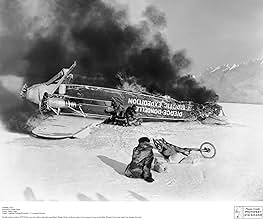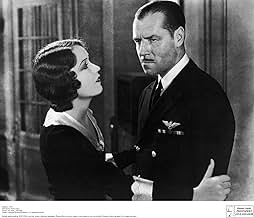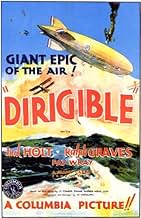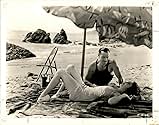Adicionar um enredo no seu idiomaJack Bradon is tasked to reach the South Pole with a dirigible.Jack Bradon is tasked to reach the South Pole with a dirigible.Jack Bradon is tasked to reach the South Pole with a dirigible.
- Direção
- Roteiristas
- Artistas
- Prêmios
- 2 vitórias no total
Emmett Corrigan
- Rear Adm. John S. Martin
- (as Emmet Corrigan)
Richard Alexander
- Radio Operator
- (não creditado)
Bess Flowers
- Party Guest
- (não creditado)
George 'Gabby' Hayes
- Parade Official
- (não creditado)
Edward Hearn
- Admiral's Aide
- (não creditado)
Selmer Jackson
- Lt. Rowland
- (não creditado)
Eddie Kane
- Lakehurst Radio Announcer
- (não creditado)
Kenneth MacDonald
- Lt. Fogarty
- (não creditado)
Adrian Morris
- Dirigible 'Los Angeles' Crewman
- (não creditado)
William H. O'Brien
- Sailor
- (não creditado)
Broderick O'Farrell
- Doctor
- (não creditado)
- Direção
- Roteiristas
- Elenco e equipe completos
- Produção, bilheteria e muito mais no IMDbPro
Avaliações em destaque
I liked this film for it conveys a can-do-attitude that was so prevalent in America at that time. This movie was made (1931) in a time when man was just beginning to test the limits of himself, machine, and the elements (it was only 5 years earlier in 1927 that Limbergh crossed the Atlantic in the Spirit of St. Louis.) This movie focused on the race to the south pole and it made for good entertainment. The special effects for the time were very good.
The human interest aspect of the film showed the negative side of ambition (how it affected a marriage and a friendship)this I found interesting. The character development in the one, Frisky, was especially satisfying.
I would recommend this movie to anyone--however do not compare it to the movies of our time--that would be a disservice to the movie.
The human interest aspect of the film showed the negative side of ambition (how it affected a marriage and a friendship)this I found interesting. The character development in the one, Frisky, was especially satisfying.
I would recommend this movie to anyone--however do not compare it to the movies of our time--that would be a disservice to the movie.
A reasonably decent motion picture for its time, the one attribute that makes this film stand out from its standard storyline, is its footage and scenes regarding dirigibles. When this film was released in 1931, it was the golden age of zeppelin travel, and the crash of the Hindenburg, which doomed this type of transportation, was still five years in the future. There were numerous scenes shot at Lakehurst Naval Air station, where ironically the Hindenburg crashed, that was the center of dirigible activity at the time for the U.S. Navy. As someone who is interested in this subject, I found this part of the movie fascinating as well as the part of the story that took you behind the scenes of airship travel and how much danger could be involved. The riveting scene dealing with the crash of a dirigible in a violent storm brought to mind the U.S. Navy zeppelin Akron, launched the same year as this film, which was destroyed in a similar storm only two years later. It was also interesting to see actress Fay Wray two years before she would gain fame with her role in King Kong. I had the opportunity to catch this film recently during an airing on the TCM cable channel and would recommend it for anyone with a similar interest.
Return to the heady days of the 1920s, when the strategic bombers of World War I were still seen as a viable alternative to the rickety airplanes of the day. While the acting is wooden and stereotypical (brave fly boy, conservative large "ship" commander, frail stay at home wife), just seeing the footage of the long-gone rigid airships is worth the tariff.
The best shot is near the beginning, when the camera pans upward, past round naval observation balloons, surprisingly modern non-rigid 'blimps' flying in formation, and then (above them all) the massive (larger by a factor of five or more) dirigible of the title.
Scenes of the real dirigible flying, landing, dropping naval "parachute men", and hooking up to the mooring mast are also worth the time.
Not so much the rest of the movie. Period special effects do not hold up well under modern scrutiny, and the silly pining away of Fay Wray really gets in the way.
(Odd too is the fact that the Review Board passed on a plot line involving an obviously cheating on her husband woman, including a racy scene at the beach where the two have been sharing an afternoon swimming, barely clad by 1930s standards). Perhaps this was during the Hays to Breen transition period, and it slipped under the radar.)
Note that the poor USS Pensacola (a mythical Navy airship; there was a cruiser by that name but never an aircraft) doesn't catch fire, despite the dramatic breakup of the structure. US airship were filled with helium (due to the almost monopolistic corner of the world's supply of helium by the US), and although they suffered through a series of dramatic crashes (Shenandoah, Akron, Macon), none of them caught fire a la the Hindenburg.
Buy it in the newly released DVD for the flying, and try to ignore the rest. (Oh, and Fay Wray looks far better as a brunette than she ever did as a blonde.)
The best shot is near the beginning, when the camera pans upward, past round naval observation balloons, surprisingly modern non-rigid 'blimps' flying in formation, and then (above them all) the massive (larger by a factor of five or more) dirigible of the title.
Scenes of the real dirigible flying, landing, dropping naval "parachute men", and hooking up to the mooring mast are also worth the time.
Not so much the rest of the movie. Period special effects do not hold up well under modern scrutiny, and the silly pining away of Fay Wray really gets in the way.
(Odd too is the fact that the Review Board passed on a plot line involving an obviously cheating on her husband woman, including a racy scene at the beach where the two have been sharing an afternoon swimming, barely clad by 1930s standards). Perhaps this was during the Hays to Breen transition period, and it slipped under the radar.)
Note that the poor USS Pensacola (a mythical Navy airship; there was a cruiser by that name but never an aircraft) doesn't catch fire, despite the dramatic breakup of the structure. US airship were filled with helium (due to the almost monopolistic corner of the world's supply of helium by the US), and although they suffered through a series of dramatic crashes (Shenandoah, Akron, Macon), none of them caught fire a la the Hindenburg.
Buy it in the newly released DVD for the flying, and try to ignore the rest. (Oh, and Fay Wray looks far better as a brunette than she ever did as a blonde.)
Lakehurst, the setting for much of this film was the epicenter of American ballooning and dirigibles, before the second world war and through it as well. A recent book, _They sailed the skies : U.S. Navy balloons and the airship program_ led me to this film, since it represents an easy way to get a look at some of the men and machines in action. Frank "Spig" Wead is the writer and Frank Capra directs. Wead of course was a flyer himself and only turned to writing after a crash broke his neck, crippling him. See WINGS OF EAGLES by John Ford for a dramatization of his life. The early sound era is not known for the sleekness of it's screen story-telling, but if you have interest in the history of zeppelins, or pre-WW2 aviaton, this film is worth watching.
Okay, I know, they are not blimps. They are Zeppelins. "Airships" was the preferred term by the U.S. Navy.
This is a very exciting action film for 1931. Apparently made with quite a high budget. I saw model shots, large sound stages filling in for Antartica, thousands of extras, real airships, and a gigantic ticker tape parade shot on location in New York City. All of these things cost much money. The U.S. Navy's use of airships was so brief that this film also marks one of the few stories about this chapter in our military history.
This film proves that Capra was also adept at high intensity action directing (for 1931) as well his usual character-driven morality plays that he became so well-known for.
The one thing that is the most striking to me about (some) early talking pictures, of which this is one, is that they have hardly any music score. This is true here, and only adds to the isolated feeling in the scenes of the doomed expedition struggling to escape from the frozen tundra. Plenty of sound effects in the scenes of the doomed Pensacola going down, but no music. In fact, the film even uses a few silent film style narration cards.
Anyway, in spite of this film dating from 1931, it has aged really well and doesn't seem too dated at all. A nice action/adventure film. The print they showed on TCM on television was in very good shape, even the sound was strong in most places. Yes, the love story seemed tacked on, but there are thousands of films in the history of Hollywood that could have survived artistically with their romantic subplots (probably inserted at the insistence of cigar-chewing studio bosses to get "the female market") jettisoned. In any case, this movie is quite entertaining and Worth checking out.
This is a very exciting action film for 1931. Apparently made with quite a high budget. I saw model shots, large sound stages filling in for Antartica, thousands of extras, real airships, and a gigantic ticker tape parade shot on location in New York City. All of these things cost much money. The U.S. Navy's use of airships was so brief that this film also marks one of the few stories about this chapter in our military history.
This film proves that Capra was also adept at high intensity action directing (for 1931) as well his usual character-driven morality plays that he became so well-known for.
The one thing that is the most striking to me about (some) early talking pictures, of which this is one, is that they have hardly any music score. This is true here, and only adds to the isolated feeling in the scenes of the doomed expedition struggling to escape from the frozen tundra. Plenty of sound effects in the scenes of the doomed Pensacola going down, but no music. In fact, the film even uses a few silent film style narration cards.
Anyway, in spite of this film dating from 1931, it has aged really well and doesn't seem too dated at all. A nice action/adventure film. The print they showed on TCM on television was in very good shape, even the sound was strong in most places. Yes, the love story seemed tacked on, but there are thousands of films in the history of Hollywood that could have survived artistically with their romantic subplots (probably inserted at the insistence of cigar-chewing studio bosses to get "the female market") jettisoned. In any case, this movie is quite entertaining and Worth checking out.
Você sabia?
- CuriosidadesThe production was shot during a California heat wave. To form vapor on the breath and give the impression that the pilots were in the Antarctic, the performers were given lumps of 'dry ice' (frozen carbon dioxide) in metal boxes to put in their mouths. Hobart Bosworth found the box cumbersome and simply put the ice in his mouth. He lost his tongue and most of his lower jaw.
- Erros de gravaçãoThe name of this Dirigible was the USS Pensacola but there was already a USN heavy cruiser of the same name that was in service since 1928 when this movie was made. The Navy does not assign duplicate names to ships/air ships in service at the same time.
- ConexõesFeatured in Frank Capra's American Dream (1997)
- Trilhas sonorasAnchors Aweigh
(1906) (uncredited)
Music by Charles A. Zimmerman
Lyrics by Alfred Hart Miles and R. Lovell
Played during the opening credits and often in the score
Sung by guests at a party
Principais escolhas
Faça login para avaliar e ver a lista de recomendações personalizadas
Detalhes
Bilheteria
- Orçamento
- US$ 1.000.000 (estimativa)
- Tempo de duração1 hora 40 minutos
- Cor
Contribua para esta página
Sugerir uma alteração ou adicionar conteúdo ausente






































